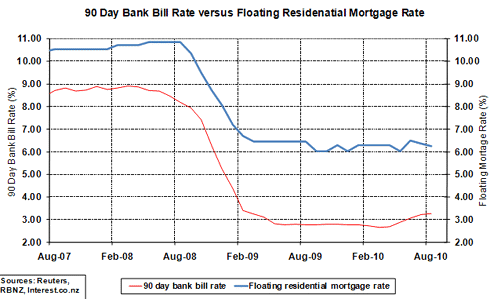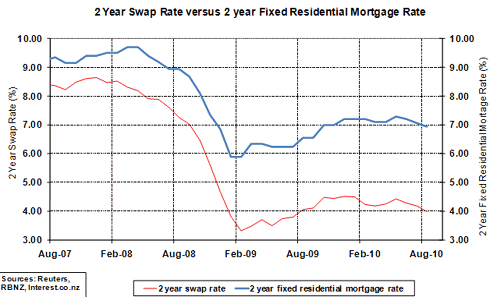
 By Roger J Kerr
By Roger J Kerr
The New Zealand economic recovery is now stumbling badly according to some media commentators and also according to moneymarket pricing of short-term interest rates (two and three year swap rates moving lower).
My reply to these assertions is a simple - bollocks!
Those who think that the NZ economy is going back down the gurgler into recession again suffer from two massive misconceptions:-
1. The economy is driven entirely by residential property prices and if those prices are not rising then the economy must be in trouble.
Boom/bust housing cycles may have played a prominent part in our economic fortunes in the past; however the housing market will be much less important going forward.
The prices of existing houses do not create real wealth or drive the economy.
2. The unemployment rate is an accurate indicator of our economic health and if that is going up we must be in trouble.
Last week’s employment numbers say more about the poor state of our economic statistics than they do about the economy over the next 12 months.
Improvement in employment always lags economic growth by 12 months.
The March quarter’s HLFS figures were plainly wrong (we said there were rogue figures at the time) and the employment decrease in the June quarter was more about correcting the earlier over-estimation of jobs growth.
There will eventually be jobs growth in the NZ economy, but perhaps it will not be so visible to those waiting in the cities for new job opportunities in retail and property. Those industry sectors will struggle to create new jobs.
The new jobs are in the heartland of new milkpowder plants, other food processing plants, new land-use, fishing and forestry etc. Agriculture exports drive this economy; however it is still surprising the number of so-called economic analysts who fail to comprehend this basic fact.
My view is that even though the milkpowder prices and thus dairy farming incomes may be volatile and uncertain, they are still high by historical standards and are a major positive for strong GDP growth next year.
Other primary industry export prices are also high and will feed into improved exporter profits, thus expansion investment and more jobs down the track.
The moneymarkets in pricing two and three year swap rates lower at this time have placed too much store on the RBNZ comments last week that the economy is not recovering as well as they expected.
The RBNZ was always far too optimistic with their 3.5% GDP growth forecast for this year. Now that they are pegging back their expectations the interest rate market has convinced itself that the removal of the early 2009 monetary stimulus is no longer warranted.
Nothing has changed with my view of the economy – a slow grind upwards to +2.00% GDP growth in 2010 and stronger export-led growth in 2011 of +4.00%.
Sideways domestic economic data is no surprise to me at this point; the recovery is not dependent on retail and housing sectors.
The exchange rate however will play a major role in determining the strength of economic growth over the next 18 months.
If the NZD/USD rate stays in the 0.7000’s the economy will struggle to reach my +4.00% forecast. If the Kiwi trades back into the 0.6000’s we should be looking good.
Borrowers have to be fixing to high levels at these artificially low market interest rates.
Investors should be holding off from two and three year investment maturities and waiting for the market rates to reverse back upwards.
Why are mortgage lending rates not increasing?
There are several very good reasons why fixed and variable mortgage rates have not really increased much in response to the two OCR increases over recent weeks.
The major one is that the banks’ cost of funds has not changed, as they do not fund as much off the domestic overnight or short-term wholesale as they used to.
Official rates (the OCR) are now merely catching up to where the true cost of money has been for some time i.e. the banks have been paying 4.5% to 5.0% for retail deposit money for some time.
Another factor is that the banks are not lending much in the home mortgage arena with residential property sale/purchase activity levels right off. You will never sell more of something or attract buyers if you are increasing your price.
As the chart below shows, variable mortgage lending rates never went below 6.00% when the 90-day wholesale rates were slashed to below 3.0% in early 2009.
The 90-day wholesale rates can increase to 4.0% (currently 3.3%) before the banks will really lift their variable lending rates (i..e restoring the traditional 2.0% margin).

The previous 1.0% margins the banks priced off in the two year mortgage market have long gone, however the current 3.0% margin is excessive. Two year wholesale swaps rates can increase from the current 4.0% to 5.0% before mortgage lending rates move much above 7.0%.

--------------------
* Roger J Kerr runs Asia Pacific Risk Management. He specialises in fixed interest securities and is a commentator on economics and markets. More commentary and useful information on fixed interest investing can be found at rogeradvice.com
No chart with that title exists.

We welcome your comments below. If you are not already registered, please register to comment.
Remember we welcome robust, respectful and insightful debate. We don't welcome abusive or defamatory comments and will de-register those repeatedly making such comments. Our current comment policy is here.